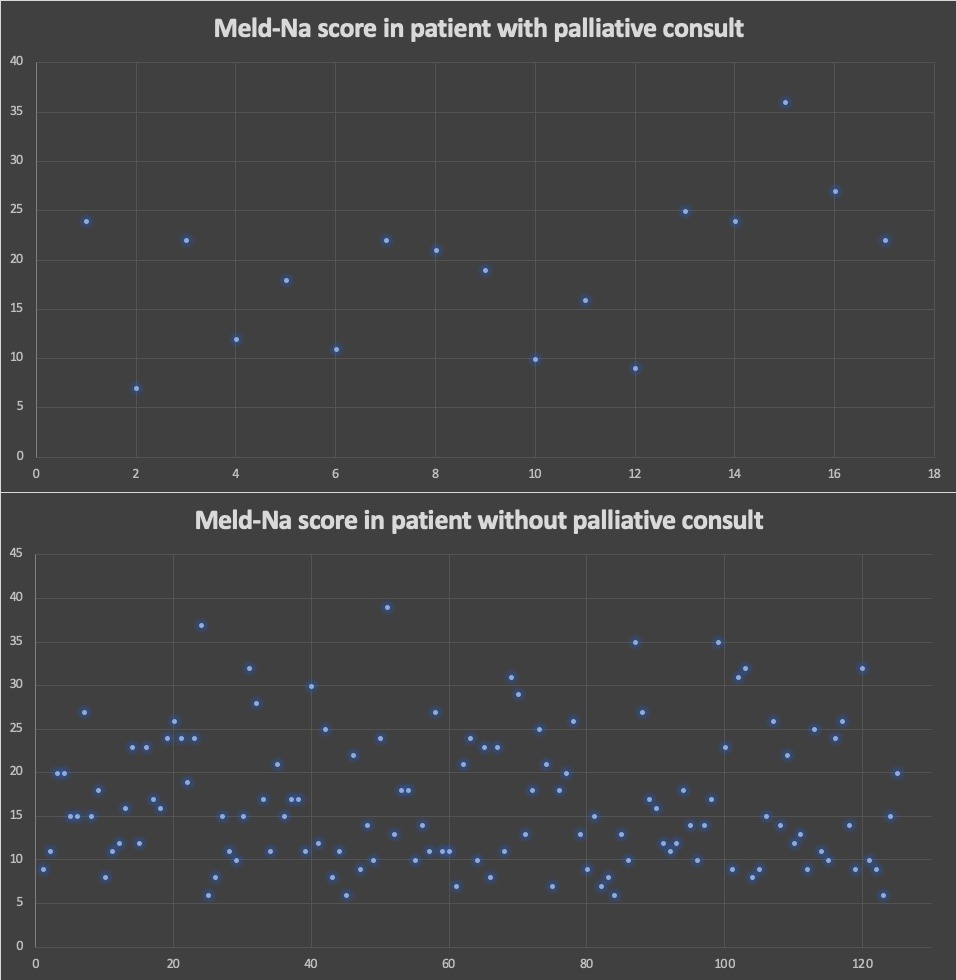Back
Poster Session D - Tuesday Morning
D0482 - Utilization of Palliative Care Service in Patients With Liver Cirrhosis in an Underserved Area, 2015-2019
Tuesday, October 25, 2022
10:00 AM – 12:00 PM ET
Location: Crown Ballroom

Ismael P. Polo Perez, MD
University of Texas Rio Grande Valley
Harlingen, TX
Presenting Author(s)
Ismael P. Polo Perez, MD1, Dailis B. Corria Cedeno, MD1, Hari Das, MS1, Giri Movva, BS2, Hari Movva, MS1, Jason R. Phillips, MD1
1University of Texas Rio Grande Valley, Harlingen, TX; 2John Sealy School of Medicine, University of Texas Medical Branch, Galveston, TX
Introduction: Palliative care is a service with a very wide vision and potent tool. Palliative care applies early in the course of terminal illness in conjunction with therapies intended to prolong life; it is not limited to end-of-life care. Patients with liver cirrhosis only have one healing treatment, a liver transplant, but the limitation in the number of donor organs and eligibility criteria reduces the number of transplants. The MELD-Na score provides validated mortality prognostic for the next 90 days in patients with liver cirrhosis. This study aimed to determine if palliative care services are underutilized and could be more evident in uninsured or undocumented patients.
Methods: Objective: Describe the use of Palliative Care service in patients with liver cirrhosis stratified by MELD Na score.
Data retrieved from Valley Baptist Medical Center in Harlingen Cerner included all patients 18 years or older with diagnoses of fibrosis or liver cirrhosis on admission or made during the hospital stay from January 2015 to December 2019. The total number of patients was 150.
Results: Distribution by sex, male 83 (55.33%), female 67 (44.67%). The mean age was 63.07 years. Predominant etiology of cirrhosis was alcoholism 64(42.67%), NASH 11 (7.33%), Viral 5 (3.33%), Other 15 (10%), and unknown 55 (36.67%). With legal status 140 patients (93.33%), and without 10 patients (6.67%). Patients with insurance 131 (87.33%) and without 19 (12.67%). Patients underwent palliative care services 16 (10.67%). A total of 50 (33.33%) patients underwent EGD. A total of 31 (20.6%) patients underwent paracentesis.
Discussion: Our result showed that the number of patients with palliative care consultations was under the expected percentage. In an external study, of 59,687 hospitalized adults with terminal decompensated cirrhosis, 29.1% received palliative care. In multiple studies, palliative care was associated with a lower procedure burden after adjusting for other factors; it was associated with a cost reduction of $8892. In our study, the cost was not evaluated, but it is expected that the patient with palliative care consults will reduce hospitalization costs. Most of the patients had insurance and legal status. The dispersion of the MELD-Na score was similar in patients with and without palliative care consultations. Our patients had a high number of EGD and paracentesis for ascites.

Disclosures:
Ismael P. Polo Perez, MD1, Dailis B. Corria Cedeno, MD1, Hari Das, MS1, Giri Movva, BS2, Hari Movva, MS1, Jason R. Phillips, MD1. D0482 - Utilization of Palliative Care Service in Patients With Liver Cirrhosis in an Underserved Area, 2015-2019, ACG 2022 Annual Scientific Meeting Abstracts. Charlotte, NC: American College of Gastroenterology.
1University of Texas Rio Grande Valley, Harlingen, TX; 2John Sealy School of Medicine, University of Texas Medical Branch, Galveston, TX
Introduction: Palliative care is a service with a very wide vision and potent tool. Palliative care applies early in the course of terminal illness in conjunction with therapies intended to prolong life; it is not limited to end-of-life care. Patients with liver cirrhosis only have one healing treatment, a liver transplant, but the limitation in the number of donor organs and eligibility criteria reduces the number of transplants. The MELD-Na score provides validated mortality prognostic for the next 90 days in patients with liver cirrhosis. This study aimed to determine if palliative care services are underutilized and could be more evident in uninsured or undocumented patients.
Methods: Objective: Describe the use of Palliative Care service in patients with liver cirrhosis stratified by MELD Na score.
Data retrieved from Valley Baptist Medical Center in Harlingen Cerner included all patients 18 years or older with diagnoses of fibrosis or liver cirrhosis on admission or made during the hospital stay from January 2015 to December 2019. The total number of patients was 150.
Results: Distribution by sex, male 83 (55.33%), female 67 (44.67%). The mean age was 63.07 years. Predominant etiology of cirrhosis was alcoholism 64(42.67%), NASH 11 (7.33%), Viral 5 (3.33%), Other 15 (10%), and unknown 55 (36.67%). With legal status 140 patients (93.33%), and without 10 patients (6.67%). Patients with insurance 131 (87.33%) and without 19 (12.67%). Patients underwent palliative care services 16 (10.67%). A total of 50 (33.33%) patients underwent EGD. A total of 31 (20.6%) patients underwent paracentesis.
Discussion: Our result showed that the number of patients with palliative care consultations was under the expected percentage. In an external study, of 59,687 hospitalized adults with terminal decompensated cirrhosis, 29.1% received palliative care. In multiple studies, palliative care was associated with a lower procedure burden after adjusting for other factors; it was associated with a cost reduction of $8892. In our study, the cost was not evaluated, but it is expected that the patient with palliative care consults will reduce hospitalization costs. Most of the patients had insurance and legal status. The dispersion of the MELD-Na score was similar in patients with and without palliative care consultations. Our patients had a high number of EGD and paracentesis for ascites.

Figure: MELD-Na score in patients divided by palliative care consult
Palliative care/Hospice consult | |||||
| Yes | % | No | % | Total |
Female | 11 | 68.75 | 56 | 41.79 | 67 |
Male | 5 | 31.25 | 78 | 58.21 | 83 |
Total | 16 | 10.67 | 134 | 89.33 | 150 |
Disclosures:
Ismael Polo Perez indicated no relevant financial relationships.
Dailis Corria Cedeno indicated no relevant financial relationships.
Hari Das indicated no relevant financial relationships.
Giri Movva indicated no relevant financial relationships.
Hari Movva indicated no relevant financial relationships.
Jason Phillips indicated no relevant financial relationships.
Ismael P. Polo Perez, MD1, Dailis B. Corria Cedeno, MD1, Hari Das, MS1, Giri Movva, BS2, Hari Movva, MS1, Jason R. Phillips, MD1. D0482 - Utilization of Palliative Care Service in Patients With Liver Cirrhosis in an Underserved Area, 2015-2019, ACG 2022 Annual Scientific Meeting Abstracts. Charlotte, NC: American College of Gastroenterology.
